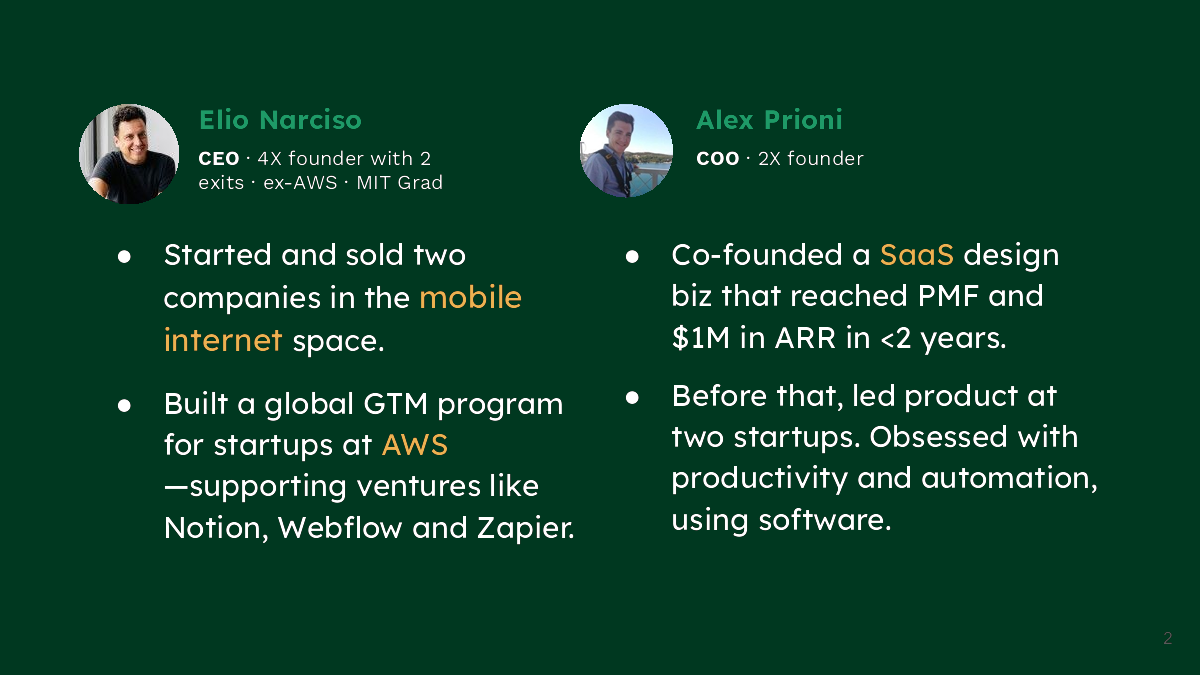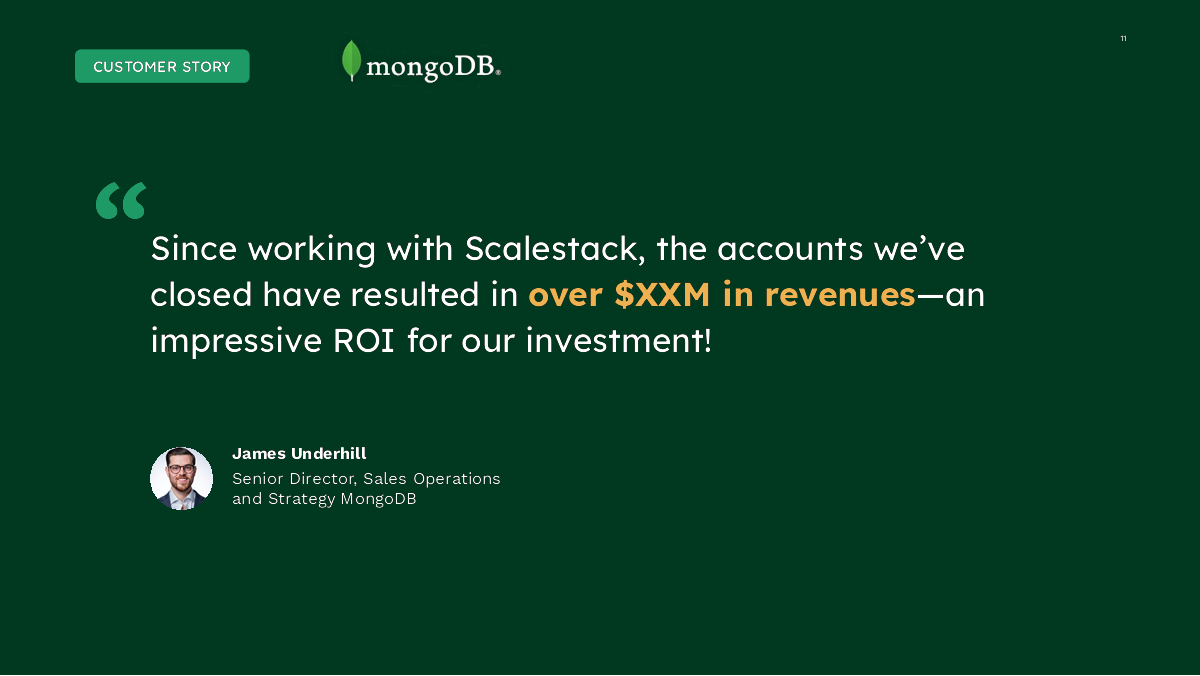AI is everywhere, and predictably, sales teams are among the early adopters. So I wasn’t surprised to see Scalestack raise $1 million to help make sales teams’ lives easier.
So, as we’ve done every week for the past 18 months or so (I can’t believe this is going to be the 75th pitch deck teardown!), we’re going to put the deck Scalestack used to raise its round under the proverbial microscope and see what it got right and where it could have done better.
Let’s go!
We’re looking for more unique pitch decks to tear down, so if you want to submit your own, here’s how you can do that.
Slides in this deck
Scalestack closed its $1 million round with an 18-slide deck. The company left all the slides in, but redacted some revenue figures and MongoDB’s ROI from its product:
- Cover slide
- Team slide
- Summary/traction slide
- Problem slide
- Problem impact slide 1
- Problem impact slide 2
- Problem impact slide 3
- Solution slide
- Traction slide
- Customer story slide 1
- Customer story slide 2
- How it works slide
- Product slide
- Market slide
- Competition slide
- Positioning slide
- Why now slide
- Closing slide
Three things to love
Over the past couple of months, I’ve been experimenting with building an AI-powered deck review tool. It gave this deck only a 67% chance of raising money (you can see the full report here). Of course, Scalestack did raise money, and it did a bunch of things extremely well, which shows that AI has a long way to go.
Taking a closer look at Scalestack’s deck, I’m not surprised the company raised money. It has three big things going for it: a killer team, impressive traction, and a customer testimonial to die for.
A great team
A company’s team is its heart and soul. In the early days of a startup, when there might not be a substantial track record or extensive financial data, the team’s background and capabilities can be one of the most persuasive aspects of your pitch.
It’s essential to present your team effectively and showcase why they are the right people to bring the business to success. That’s what Scalestack got right, and it cleverly starts the story with a team slide.

You know what investors love? Founders with proven track records. This slide shows that its team is well-connected in the startup world and has operational experience to boot.
I’d have loved to see links to the founders’ LinkedIn profiles as well, but this works beautifully nevertheless.
Long-time readers might notice that this slide is missing something I often argue for on team slides: Founder-market fit. Nothing in these biographies screams “sales” or “AI” to me, so why am I so enthusiastic about this company? Well, that’s because it doesn’t matter when you click through to the next slide:
Traction for dayyyyssss
Your startup’s team is important, but traction will make up for all the sins you can imagine. It makes sense, then, that after a team slide that good, Scalestack follows up with a traction victory lap. The actual data is redacted, but you get the picture.

Even with redacted numbers, this slide tells a hell of a story: Marquee customers, growing ARR and a strong pipeline. That checks a lot of boxes. The team will probably have been able to raise money with just these two slides, which is why I don’t give them that hard of a time for missing some important parts. Would it have been better to include all the data investors would be looking for? Sure, but if you have traction and a solid team, you’re 90% of the way there.
If you’re raising money, take a hard look at these two slides. That’s what you’re up against, even for a company raising “only” $1 million. Does your company look like that? If not, can you tell a story that has a similar refrain?
And if you can, will you be able to end the story with something this powerful?
A hell of a customer testimonial
Let’s get something straight: Customer testimonials are, by and large, vanity metrics that don’t tell the story by themselves. However, they can make for powerful narrative elements.

You’d better believe that if I were leading an investment in Scalestack, I’d want to have a chat with Mr. Underhill. If he’s just as enthusiastic about this company on the reference call as well, it’d go a long way to convincing me to invest.
Is it all perfect, though? Well, no. Objectively, this is not a very good pitch deck, because it’s missing some major parts of the pitch. So in the rest of this teardown, we’ll look at three things Scalestack could have improved or done differently, along with its full pitch deck!
Three things that could be improved
Scalestack missed out some major parts of the pitch.
No ask or use of funds slides
The biggest, most puzzling part of this pitch deck is that there’s no price tag or product description, which is unforgivable considering this is a sales tech company. I’m not talking about the product the company is building, but the product it is selling to the VCs.
The price tag is the amount of money the company is hoping to raise. The product is the roadmap for what the company will do with the money to further de-risk and scale. Scalestack doesn’t do a bad job — it doesn’t even attempt to paint a picture of the future.
It’s completely bizarre, but it goes to show that the founders understand something crucial about this fundraising round: The investors need to trust them to know what they are doing. This is a bold move that I’d never recommend to any of my pitch coaching clients, but here we are: It worked!
Missing business basics
The company is reporting ARR, which is great, but it didn’t talk at all about its pricing model or go-to-market strategy. Again, it’s pretty weird for a sales-focused tool. Investors are going to want to understand all of those levers and how the team is planning to evolve. It speaks to the startup’s market awareness, business acumen and potential for success.
A pricing model serves as a clear signal of your startup’s understanding of its value proposition and target market. It demonstrates that you have deep insight into the economics of your product or service, especially its value in the market. This is essential for investors, as it shows that you are pragmatic about the company’s financial viability. A well-structured pricing model assures investors that you have a strategic approach to revenue generation — a critical aspect of business growth and scalability.
The lack of a go-to-market strategy also baffles me. This strategy is a roadmap that describes the steps your startup will take to engage with customers and achieve market penetration. It ought to include details on marketing channels, customer acquisition strategies and sales tactics. Investors are keen to understand how you plan to reach and retain your customers, as this directly impacts the startup’s ability to generate sustainable revenue.
A strong go-to-market strategy demonstrates your team’s operational competence and ability to execute your business plan effectively. Missing it is a bit of a blunder, in my opinion.
So who are the customers?
Closely tied to the go-to-market mistake above, the team doesn’t appear to have a clear customer profile. In other words: It doesn’t communicate who its customers are.
A well-defined customer profile demonstrates that you have a deep understanding of your target market. Customer profiles (or personas, target demographics, whatever you choose to call the slide) can include demographic, psychographic and behavioral characteristics of your ideal customers, illustrating that your startup is not just building a product, but solving a real problem for a specific group of people.
Narrowly defining who your customers are, what they need, and how they make purchasing decisions unlocks your sales process and shows investors that you know where to start looking for your customers.
The full pitch deck
If you want your own pitch deck teardown featured on TC+, here’s more information. Also, check out all our Pitch Deck Teardowns and other pitching advice, all collected in one handy place for you!































Comment